Spotify Technology Bundle
How Did Spotify Disrupt the Music Industry?
Before streaming, music consumption was a fragmented landscape of physical media and illegal downloads. Spotify's 2006 debut in Stockholm, Sweden, marked a turning point, offering a legal and convenient streaming model. Founded by Daniel Ek and Martin Lorentzon, the platform quickly became a pioneer, transforming how the world accesses audio content.
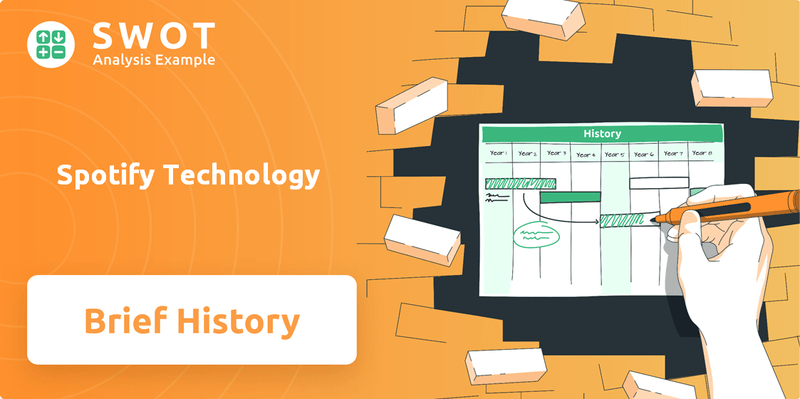
From its Spotify Technology SWOT Analysis to global dominance, understanding the Spotify history is crucial for any investor or business strategist. The Spotify company's journey, from its Spotify launch to its current status as a global audio powerhouse, showcases its evolution. Explore the brief history of Spotify's beginnings, its early challenges, and how it changed the music industry, solidifying its place in the digital entertainment landscape.
What is the Spotify Technology Founding Story?
The Spotify history begins in April 2006. It was when Daniel Ek and Martin Lorentzon officially founded Spotify company in Stockholm, Sweden. Their goal was to combat music piracy and revolutionize how people accessed music.
The founders saw a gap in the market. They aimed to create a legal, accessible, and user-friendly music platform. This would compete with illegal downloading and fragmented digital music services. Their solution was a streaming service that offered a vast catalog of music.
The Spotify launch was built upon a freemium model. This model provided free, ad-supported access to music. It also offered a premium subscription tier with ad-free listening and additional features. The initial product was a desktop application for streaming music.
Daniel Ek and Martin Lorentzon founded Spotify in April 2006. They aimed to solve the problem of music piracy.
- The name 'Spotify' came from a misheard idea.
- Lorentzon's personal wealth provided initial funding.
- The platform's early focus was on a desktop application.
- The founders' tech and online business expertise were crucial.
The early funding came mainly from Lorentzon's resources. This funding was essential for developing the platform and securing early music licensing deals. The team's background in technology and online business was key. It helped them navigate music rights and build a strong streaming infrastructure.
For insights into how Spotify has grown its user base and revenue, check out the Marketing Strategy of Spotify Technology.
As of Q1 2024, Spotify had 239 million Premium subscribers. The total monthly active users (MAU) reached 615 million. Spotify's revenue for Q1 2024 was approximately €3.6 billion. These figures highlight Spotify's significant growth and market presence since its founding.
Spotify Technology SWOT Analysis
- Complete SWOT Breakdown
- Fully Customizable
- Editable in Excel & Word
- Professional Formatting
- Investor-Ready Format
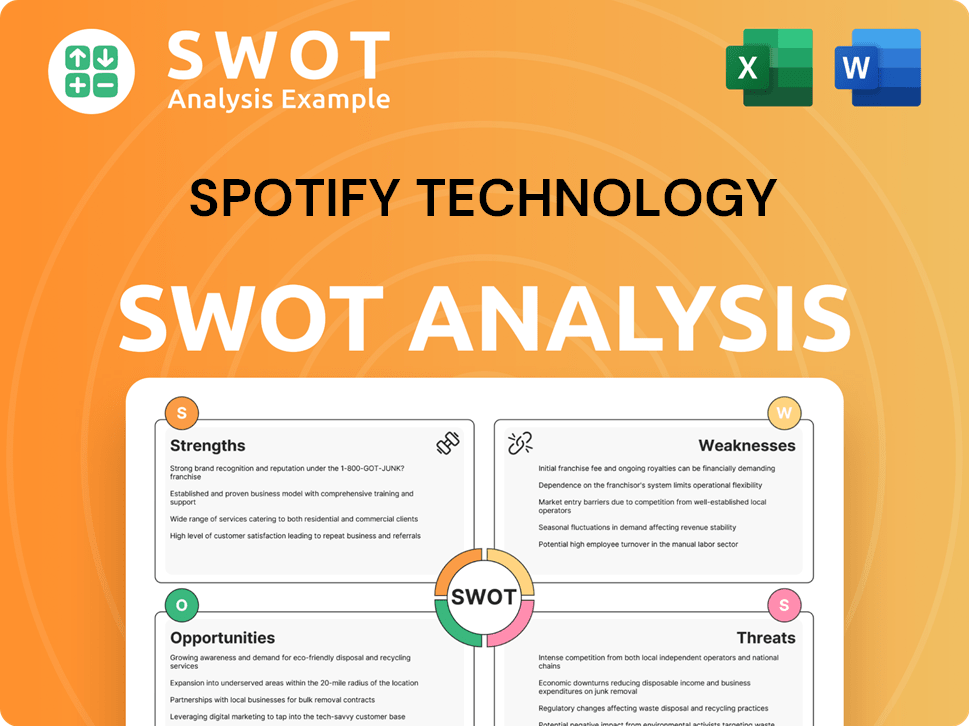
What Drove the Early Growth of Spotify Technology?
The early growth and expansion of the music streaming service, now known as the Spotify company, was marked by a strategic rollout and a focus on user experience. Following its 2008 launch, the platform initially targeted European markets before expanding globally. This period saw the refinement of its desktop application and the expansion of its music catalog through crucial licensing agreements.
The Spotify launch began in Europe, strategically entering markets like the UK, France, and Spain. This phased approach allowed for localized testing and adaptation. The initial focus was on building a strong user base and refining the platform's core functionalities. The company's early success in Europe set the stage for its global expansion.
A significant milestone in the Spotify history was the 2011 launch in the United States. This expansion broadened its addressable market significantly. The US launch was highly anticipated and contributed to rapid user growth. This expansion was key to the company's future success.
Early user acquisition relied on word-of-mouth and an invite-only system, creating exclusivity. This approach helped manage server load and generate buzz. By 2011, the platform had over 1 million paying subscribers globally. This strategy was pivotal in building an initial user base.
Daniel Ek continued as CEO, guiding the company through its expansion. Significant funding rounds, including a Series A in 2008, enabled scaling and content acquisition. These investments were crucial for technological advancements and securing licensing agreements. For more information on the company's structure, see Owners & Shareholders of Spotify Technology.
Spotify Technology PESTLE Analysis
- Covers All 6 PESTLE Categories
- No Research Needed – Save Hours of Work
- Built by Experts, Trusted by Consultants
- Instant Download, Ready to Use
- 100% Editable, Fully Customizable
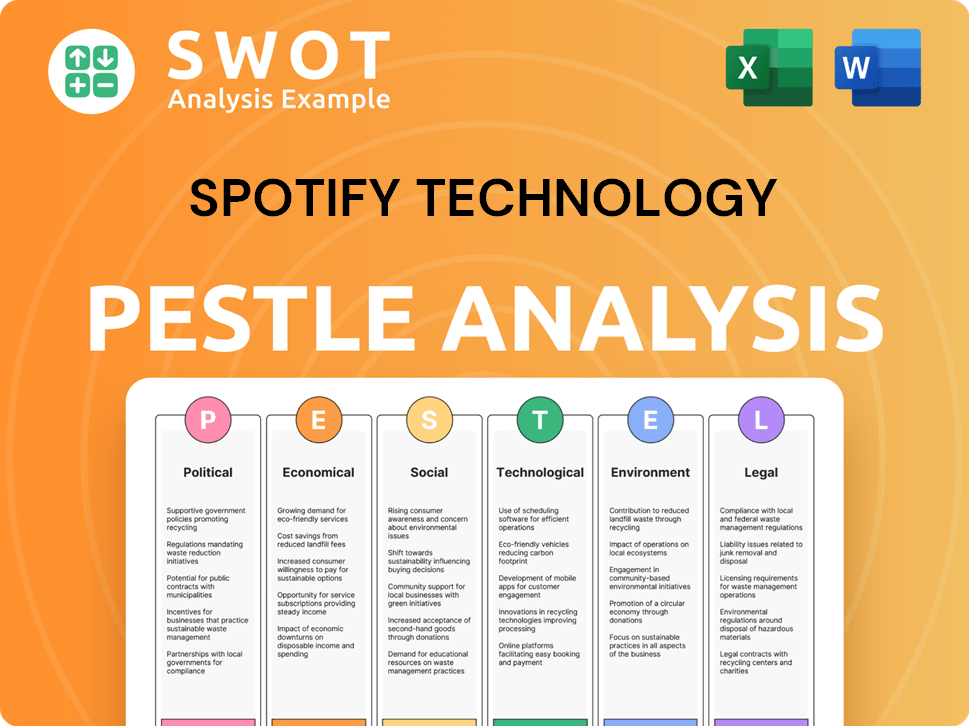
What are the key Milestones in Spotify Technology history?
The Spotify company has a rich history, marked by significant milestones that have shaped its journey. The company's story is a testament to innovation and resilience in the ever-evolving landscape of the music industry.
| Year | Milestone |
|---|---|
| 2006 | Daniel Ek and Martin Lorentzon founded the music streaming service. |
| 2008 | Spotify launched in Sweden, marking the beginning of its journey in the music streaming market. |
| 2011 | Spotify expanded into the United States, significantly broadening its user base. |
| 2018 | Spotify went public on the New York Stock Exchange through a direct listing, solidifying its market presence. |
| 2024 | Spotify reported a positive operating income of €168 million in Q1, indicating progress in profitability. |
Innovations have been at the core of Spotify's strategy, driving its growth and shaping the music streaming experience. Personalized playlists and discovery features, such as 'Discover Weekly,' have revolutionized how users find and engage with music.
Spotify's introduction of personalized playlists, like 'Discover Weekly,' changed music discovery. These features use algorithms to curate music based on user preferences, enhancing the listening experience.
Spotify integrated podcasts into its platform, starting in 2015, diversifying its content. This move has expanded its appeal and attracted new audiences, turning into a major growth area.
Key partnerships with device manufacturers and telecommunication companies expanded Spotify's reach. These collaborations have helped Spotify gain access to a wider audience and increase its user base.
Spotify's direct listing on the New York Stock Exchange in April 2018 was a groundbreaking move. This approach allowed early investors to gain liquidity and showcased the company's market value.
Spotify diversified its content offerings beyond music, investing heavily in podcasts and audiobooks. This strategy aims to improve margins and attract a broader audience.
The implementation of dynamic ad insertion technologies has been a key innovation. This allows for targeted advertising within podcasts, enhancing revenue streams.
Despite its successes, the Spotify company has faced several challenges. Persistent profitability struggles due to high royalty payments and intense competition from rivals like Apple Music have been ongoing concerns.
High royalty payments to artists and record labels have made it difficult for Spotify to achieve consistent profitability. The company is continually seeking ways to improve its financial performance.
Intense competition from major tech companies like Apple Music and Amazon Music has demanded continuous innovation and investment. Spotify must stay ahead to maintain its market leadership.
Controversies surrounding artist compensation have posed challenges for Spotify. Addressing these issues is crucial for maintaining positive relationships within the music community.
Navigating content moderation issues, particularly with podcasts, has been a challenge. Spotify must balance free speech with the need to ensure responsible content.
Diversifying revenue streams beyond music is a key strategy to improve margins. This includes investments in podcasts, audiobooks, and other forms of audio content.
A relentless focus on user engagement is vital for maintaining market leadership. This includes continually improving the user experience and offering compelling content.
Spotify Technology Business Model Canvas
- Complete 9-Block Business Model Canvas
- Effortlessly Communicate Your Business Strategy
- Investor-Ready BMC Format
- 100% Editable and Customizable
- Clear and Structured Layout
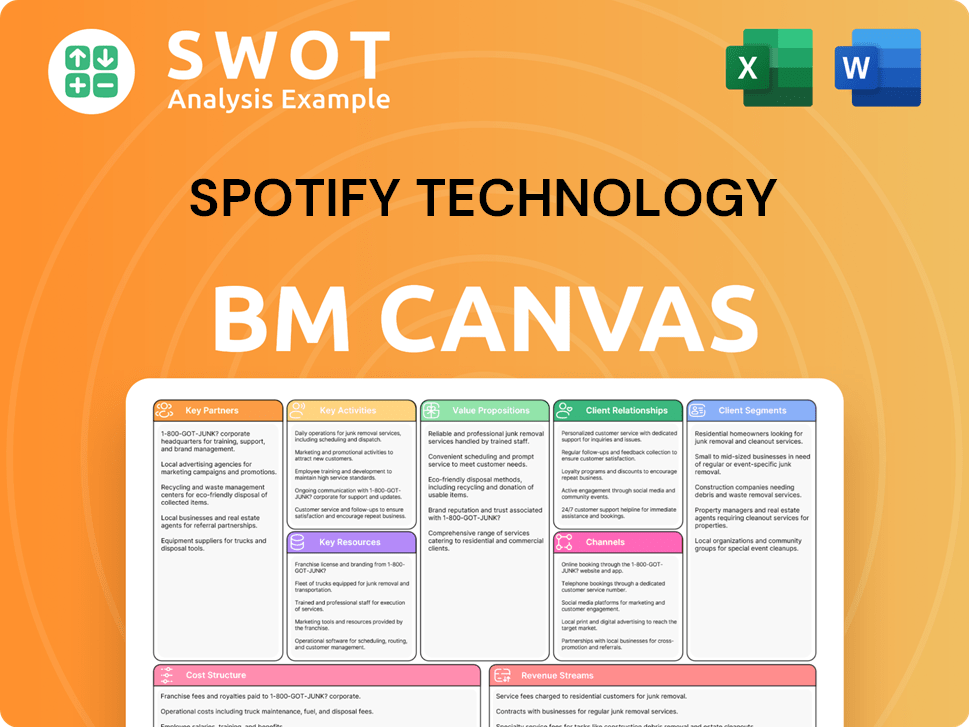
What is the Timeline of Key Events for Spotify Technology?
The Spotify company has revolutionized the music industry since its inception, marked by significant milestones and a journey of innovation. From its humble beginnings in Stockholm, Sweden, to its current status as a global audio platform, Spotify's history is a testament to its adaptability and vision. This Spotify history showcases how the company has grown and evolved, shaping the way people consume audio content today. The Spotify timeline reveals key moments that have defined its trajectory.
| Year | Key Event |
|---|---|
| 2006 | Spotify was founded in Stockholm, Sweden, by Daniel Ek and Martin Lorentzon. |
| 2008 | Spotify officially launched in Europe, marking its first expansion beyond Sweden. |
| 2011 | Spotify launched in the United States, significantly broadening its user base. |
| 2015 | Spotify introduced podcasts to its platform, diversifying its content offerings. |
| 2017 | Spotify reached 140 million monthly active users, demonstrating substantial growth. |
| 2018 | Spotify went public on the New York Stock Exchange through a direct listing, a significant financial milestone. |
| 2019 | Spotify acquired Gimlet Media and Anchor, signaling a major push into podcasts and audio content creation. |
| 2020 | The Joe Rogan Experience podcast became exclusive to Spotify, attracting a large audience. |
| 2023 | Spotify reached over 500 million monthly active users, showcasing its extensive reach. |
| 2024 | Spotify reported 676 million monthly active users and 269 million premium subscribers in Q1, highlighting its strong market position. |
Spotify is focused on expanding its presence in emerging markets, aiming to increase its global reach. The company is also working to solidify its position as the world's leading audio platform. This strategy includes adapting to local preferences and overcoming challenges in different regions. This Spotify company is always looking for new markets.
Strategic initiatives include continued investment in exclusive podcast and audiobook content to drive subscriber growth and improve profitability. Spotify is exploring new monetization avenues, such as live audio features and enhanced advertising technologies. The company is also focused on personalizing the user experience through AI-powered recommendations.
Analyst predictions suggest continued growth in its subscriber base, though profitability remains a key focus. Spotify is working to improve its financial performance by increasing its subscriber base and exploring new revenue streams. The company's ability to achieve and sustain profitability will be critical for its long-term success.
Industry trends like the rise of AI-powered content creation and personalized audio experiences are likely to impact Spotify's future development. Spotify is investing in new technologies to improve its platform, such as AI-driven content recommendations and enhanced advertising capabilities. The company is poised to adapt to these trends and maintain its competitive edge.
Spotify Technology Porter's Five Forces Analysis
- Covers All 5 Competitive Forces in Detail
- Structured for Consultants, Students, and Founders
- 100% Editable in Microsoft Word & Excel
- Instant Digital Download – Use Immediately
- Compatible with Mac & PC – Fully Unlocked
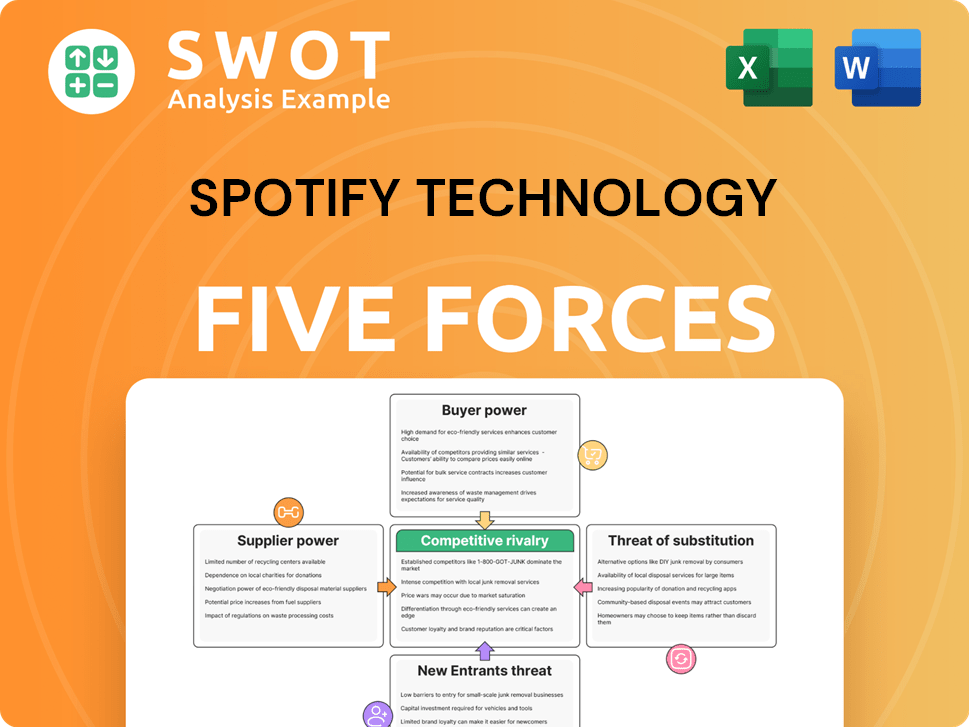
Related Blogs
- What is Competitive Landscape of Spotify Technology Company?
- What is Growth Strategy and Future Prospects of Spotify Technology Company?
- How Does Spotify Technology Company Work?
- What is Sales and Marketing Strategy of Spotify Technology Company?
- What is Brief History of Spotify Technology Company?
- Who Owns Spotify Technology Company?
- What is Customer Demographics and Target Market of Spotify Technology Company?
Disclaimer
All information, articles, and product details provided on this website are for general informational and educational purposes only. We do not claim any ownership over, nor do we intend to infringe upon, any trademarks, copyrights, logos, brand names, or other intellectual property mentioned or depicted on this site. Such intellectual property remains the property of its respective owners, and any references here are made solely for identification or informational purposes, without implying any affiliation, endorsement, or partnership.
We make no representations or warranties, express or implied, regarding the accuracy, completeness, or suitability of any content or products presented. Nothing on this website should be construed as legal, tax, investment, financial, medical, or other professional advice. In addition, no part of this site—including articles or product references—constitutes a solicitation, recommendation, endorsement, advertisement, or offer to buy or sell any securities, franchises, or other financial instruments, particularly in jurisdictions where such activity would be unlawful.
All content is of a general nature and may not address the specific circumstances of any individual or entity. It is not a substitute for professional advice or services. Any actions you take based on the information provided here are strictly at your own risk. You accept full responsibility for any decisions or outcomes arising from your use of this website and agree to release us from any liability in connection with your use of, or reliance upon, the content or products found herein.